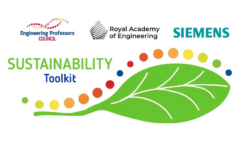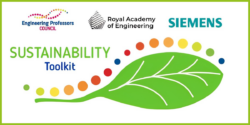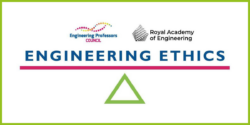With nearly 15,000 views to date (as of March 2025), it’s not surprising that awareness of the Sustainability Toolkit is growing. This has also been boosted by academics and advocates including the Toolkit in their events and talks.
In the last few months, the Sustainability Toolkit has been featured at recent events both home and abroad:
- June 2025: Several Sustainability Toolkits contributors and Steering Group members will be sharing transformational and innovative ideas at the Twelfth International Conference on Engineering Education for Sustainable Development to be held at King’s College London in June 2025. These include papers by Rhythima Shinde (Sustainability Toolkit Content Review Coordinator), Goudarz Poursharif, Emanuela Tilley, and Panos Doss (Sustainability Toolkit Steering Group members), Rehan Shah, Laura Fogg-Rogers, Valentina Rossi, Cindy Anderson, and Manoj Ravi (Sustainability Toolkit contributors), and Diana Martin (Sustainability Toolkit contributor). In addition, Rehan Shah will be presenting a workshop on promoting equity through community-based learning, Dawn Bonfield and Madeline Polmear will be presenting a workshop on game-based learning for sustainability, and Goudarz Poursharif and Panos Doss will be presenting a workshop on embedding multidisciplinary sustainability challenges in curricula. The Sustainability Toolkit will be promoted in workshops conducted by Sarah Hitt and Cindy Anderson that focus on navigating transformational change and co-creating sustainable engineering curricula. Sarah Hitt (Toolkits Project Manager) and Emma Crichton (Ethics Toolkit Steering Group member) will also deliver a keynote address.
- 22nd April 2025: The EPC’s Sustainability Toolkit was featured in a global virtual event to celebrate Earth Day on Tuesday 22nd April. Hosted by the Sustainability Special Interest Group of the European Society for Engineering Education (SEFI), over 100 people from around the world registered for “Sustainability Engineering Education for One Earth”. Besides the Sustainability Toolkit, the event highlighted the Engineering for One Planet Framework, the Siemens Immersive Design Challenge, and other efforts from the Norwegian University of Science and Technology and Airbus designed to engage engineering students in sustainability issues.
- 21st November 2024: Education and Skills for Climate Adaptation in Engineering
Lydia Amarquaye, IMechE’s Education & Skills Policy Lead, has written a hard-hitting blog on the changes needed to ensure engineering supports a more sustainable world. She makes three policy recommendations for government and commends the EPC’s Sustainability Toolkit.
- On 13th November 2024, Toolkit Project Manager, Professor Sarah Jayne Hitt, promoted the Toolkit in a webinar that she co-presented for the European Federation of Chemical Engineers on “How to teach sustainability”. This is available to watch on YouTube.
- At the SEFI Annual Conference, held at EPFL in Lausanne, Switzerland on the 2nd-5th September 2024, Professor and Toolkit project manager Sarah Jayne Hitt co-facilitated a workshop on the Toolkit and other curriculum resources developed by Engineering for One Planet and Engineers Without Borders UK.
- At the SEFI Annual Conference, held at EPFL in Lausanne, Switzerland on the 2nd-5th September 2024, UCL Lecturer Vivek Ramachandran advocated for using both the Sustainability and Ethics Toolkits in his paper on “Integrating Responsible Innovation into Engineering Education: Insights from Scenario Leads at UCL’s Integrated Engineering Programme.”
- Dr Lampros Litos, Sustainability Toolkit Contributor and Lecturer in Sustainability Manufacturing Operations at Cranfield, promoted the Toolkit at the EPSRC Early Career Forum in Manufacturing Research 2024.
- At the ICL-IGIP Conference, held at TalTech in Tallinn, Estonia, the 24th-27th September 2024, Prof. Hitt presented a paper co-written with Emma Crichton and Dr Jonathan Truslove of EWB UK on how the Sustainability Toolkit, Systems Change Lab, and Reimagined Degree Map can help foster a culture of changemaking in engineering education.
We want to know about where you’re talking about the Sustainability Toolkit! Have you featured a resource in a conference presentation or meeting? Tell us about how the resources have helped you over the past year – we’d love to feature your story.
This post is also available here.



